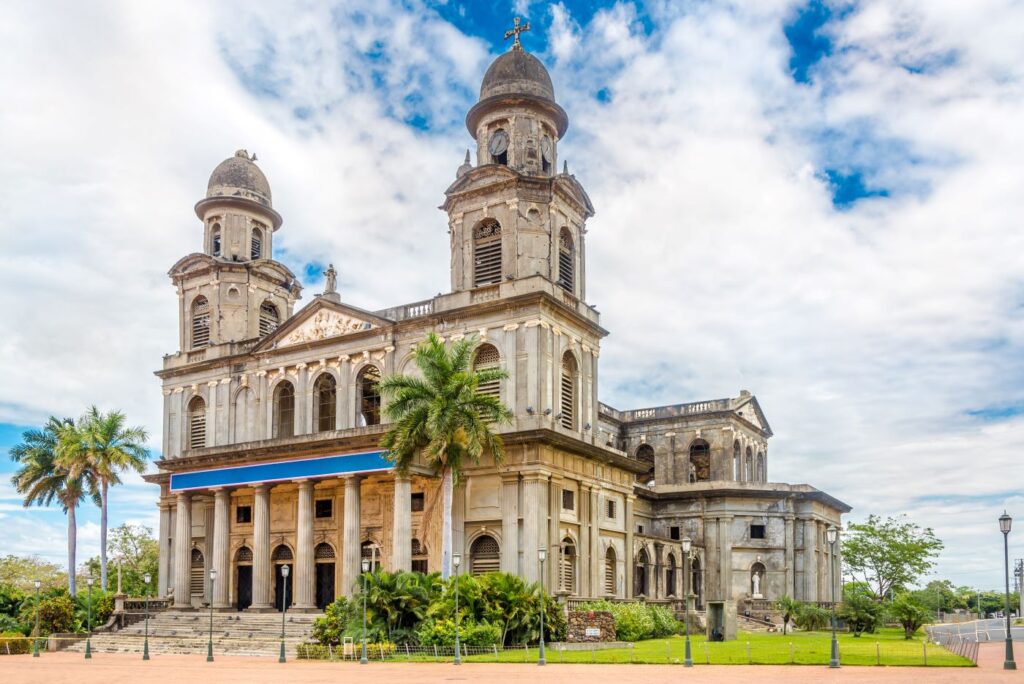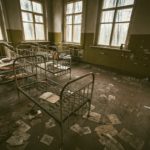In August 2023, Daniel Ortega, president of Nicaragua and leader of the Sandinista Party, expropriated the prestigious Jesuit-run Central American University (UCA). His government confiscated UCA’s buildings and assets and evicted more than a dozen Jesuit priests living on campus. A week later, his government legally dissolved the Society of Jesus in Nicaragua and seized its finances and property, including hundreds of Fe y Alegría schools serving low-income families in rural areas.
These were the latest in a string of anti-Catholic actions taken by Ortega. Since 2022, his government has banned public Catholic gatherings, including the Easter procession, in most municipalities. It is surveilling Masses. It has expelled several Catholic missions and charities from the country and shut down or confiscated over two dozen Catholic colleges. It has imprisoned and exiled a dozen Catholic priests. It recently sentenced the bishop of Matagalpa, Rolando Álvarez, the Nicaraguan Church’s leading government critic, to twenty-six years in prison.
A lot can change in two generations. In the 1970s and 1980s, liberationist Catholics played a critical role in the Sandinista revolution. Many left-wing priests and Catholic activist networks participated in the multi-year insurrection that toppled dictator Anastasio Somoza. Four revolutionary priests served as ministers in Ortega’s first Sandinista government from 1979 to 1990.
Ortega’s evolution from revolutionary in the 1970s to dictator in the 2010s and 2020s is not especially surprising. As Steven Levitsky and Lucan Way argue in their 2022 book, Revolution and Dictatorship, successful revolutions—e.g., France in 1789, Russia in 1917, China in 1949, Cuba in 1959, Nicaragua and Iran in 1979—tend to give rise to repressive, often totalitarian dictatorships. Revolutionary regimes notoriously “eat their own,” narrowing and turning against the individuals and groups that initially supported them.
Start your day with Public Discourse
Sign up and get our daily essays sent straight to your inbox.Nicaragua is no exception. In the 1970s and 1980s, Ortega depended on the support of Catholics. Now he is targeting them, including former allies. Nicaragua’s revolutionary Catholics bear some responsibility for this turn of events. By participating in the Sandinista revolution that brought Ortega to power, they unwittingly helped to sow the seeds of the Nicaraguan Church’s present crisis.
By participating in the Sandinista revolution that brought Ortega to power, they unwittingly helped to sow the seeds of the Nicaraguan Church’s present crisis.
In 1979, Ortega and the Church were engaged in a common struggle against the corrupt, violent dictatorship of Anastasio Somoza. Social opposition to Somoza took off in the aftermath of the 1972 Managua earthquake, which killed thousands, left hundreds of thousands homeless, and destroyed eighty percent of Managua’s commercial property. To the outrage of the public, Somoza used much of the international relief aid to enrich himself and his cronies. By 1974, he personally owned roughly a quarter of the Nicaraguan economy.
Somoza became deeply unpopular, and revolution was in the air. The recent Cuban revolution had inspired a generation of Latin American college students, including the leadership of the left-wing guerrilla organization the Sandinista National Liberation Front (FSLN). In 1974, the FSLN resurfaced and began an insurrection against the Somoza regime. Ex-political prisoner Daniel Ortega was one of its main leaders.
Around this time, liberation theology, a fusion of Christianity and Marxism, caught fire among progressive Latin American Catholics. Many Catholic university students in Nicaragua, including at UCA, sympathized with the Sandinistas and actively collaborated with them. So did a number of influential priests.
But the vast majority of the clergy and laity, including the Church’s most well-known and influential prelates, did not support the revolutionaries at this time. Although they broke with Somoza in the mid-1970s because of his corruption and ineptitude, they rejected armed struggle and advocated a peaceful transition to democracy. Only in 1979, after Somoza refused to submit to a negotiated transfer of power and resorted to extreme repression, did the Catholic establishment come to regard the insurrection as a tragic necessity.
Remarkably, the insurrection succeeded. In 1979, after insurgent forces encircled Managua, Somoza resigned and fled the country. Father Miguel Obando y Bravo, the Archbishop of Managua and Nicaragua’s most popular figure, said a Mass celebrating Somoza’s fall and commemorating the dead.
The Sandinistas emerged as Nicaragua’s dominant political force, and Liberationist priests occupied major roles in the new Sandinista regime. Father Fernando Cardenal oversaw a nationwide literacy campaign in 1980 and later assumed the role of education minister from 1984 to 1990. Three other priests served in cabinet positions: Father Miguel d’Escoto as foreign minister (1979-90), Father Ernesto Cardenal as minister of culture (1979-87), and Father Edgard Parrales as minister of social welfare (1980-82) and permanent U.N. representative (1982-86). In addition, Envío, a Jesuit magazine founded at UCA in 1981, provided sympathetic coverage to the Sandinistas and Ortega throughout the 1980s.
But the Church as a whole kept a critical distance from the government and, after a short period, turned against Ortega and the Sandinistas. Archbishop Obando y Bravo and fellow prelates raised early concerns about the spread of “godless communism.” They castigated leftist demonstrators who disrupted a Mass celebrated by Pope John Paul II during his 1983 visit to Nicaragua. They condemned the Sandinistas’ legalization of abortion and promotion of contraception. They argued against liberation theology and banned the Liberationist Nicaraguan Peasants’ Mass. They rebuked the revolutionary priests in the cabinet for violating Catholic canon law. In 1985, Obando y Bravo toured the country and forcefully criticized the Sandinistas in well-attended public addresses.
Pope John Paul II supported the Nicaraguan bishops. In his 1983 visit, he scolded Fr. Ernesto Cardenal on the tarmac of the Managua airport and told him he must resign from his cabinet position. After Cardenal and the other revolutionary priests refused, the pope laicized Parrales (on Parrales’s request) and suspended the priesthoods of the other three. He also pressured the Jesuits to expel Father Fernando Cardenal. In 1985, he made Archbishop Obando y Bravo a cardinal.
Responding to the suspension, Fernando Cardenal wrote in a 1984 open letter that he could not “conceive of a God that would ask [him] to abandon [his] commitment to the people.” It was possible, he opined, to be faithful to the Church “and also devote [himself] to the service of the poor in Nicaragua from within the Sandinista revolution.”
Notably, the Nicaraguan Church establishment did not condemn the Contras. Shortly after the Sandinistas took power, a broad anti-Sandinista counterinsurgency developed (the “Contras”), with financial and military assistance from the U.S. The insurgents included ex-members of the Somoza regime, disillusioned ex-revolutionaries, and anti-Sandinistas who had not directly participated in the revolutionary conflict. Obando y Bravo admitted a “certain sympathy” for them, and the Bishop of Juigalpa, Pablo Vega, affirmed their right to insurrection.
As the Contras war escalated, the Sandinistas clamped down on civil liberties, including those of the Church. State-run media attacked opposition priests and bishops. The government expelled ten foreign priests. Bishop Vega visited Washington, D.C. in 1986 to defend the Contras, after which the Sandinistas sent him into exile. The Sandinistas also exiled Fr. Bismarck Caballo, director of Radio Católica and an influential government critic. Catholic leaders, including Archbishop Obando y Bravo, condemned these actions.
In the 1990 presidential election, Ortega suffered a surprise defeat, in part due to opposition from the Church. Prelates and priests quietly supported opposition candidate Violeta Chamorro, and Obando y Bravo endorsed her in his Sunday sermons. Many Catholic grassroots groups participated in Chamorro’s campaign.
Ortega lost two subsequent reelection bids, in 1996 and 2001. Before the 1996 election, Obando y Bravo urged Nicaraguans not to vote for Ortega, and the Sandinistas retaliated by publicly attacking the Church. But following his 2001 loss, Ortega sought to make amends with the Church. He apologized for past hostilities and promised, if elected in 2006, to pass an unconditional abortion ban. He also agreed to marry his partner, Rosario Murillo, in a Catholic ceremony. A deal was struck, and as a gesture of reconciliation, Archbishop Obando y Bravo said a Mass on the 25th anniversary of the Sandinista revolution and officiated the Ortega–Murillo marriage in 2005.
Ortega’s gambit paid off. In 2006, he improbably returned to power, riding a wave of left-wing presidential victories across Latin America. He has not left the presidency since.
Today, Nicaragua is one of only three dictatorships in Latin America. Each year, Freedom House gives every country in the world a political freedom score between zero (completely unfree) and 100 (completely free). This year, the twenty countries of Latin America received an average score of sixty-four and a median score of sixty-nine. Only three countries scored below a forty-eight: Cuba at twelve, Venezuela at fifteen, and Nicaragua at nineteen. Cuba, Venezuela, and Nicaragua are stark authoritarian outliers in the region.
Ortega’s regime has come to resemble Somoza’s in many ways: nepotistic, corrupt, and repressive. His wife holds the vice presidency, and Ortega loyalists dominate all branches of government. A stacked Supreme Court manipulated the Nicaraguan constitution in 2011 and 2014 to allow Ortega indefinite reelection. In the lead-up to the 2016 presidential election, it barred several opposition candidates from running against Ortega.
Since 2014, Ortega has faced a series of mass protests that peaked in intensity in 2018. In response, the Ortega government descended into full-fledged authoritarianism, killing hundreds of protesters and imprisoning over a thousand.
The UCA was a major hub of the protests, and rector Fr. José Idiáquez opened the campus as a safe haven for imperiled demonstrators. In response, the Ortega government denied Idiáquez re-entry to Nicaragua after he took a trip abroad. Later, the government cut off the UCA’s public funds.
Ortega has clamped down on all forms of opposition since 2018. His government has arrested dozens of opposition politicians, permanently banned leading presidential rivals from contesting or holding office, and shut down opposition media outlets and scores of universities and civil society organizations. Roughly 200,000 Nicaraguans have sought refuge in neighboring Costa Rica.
At significant personal and institutional risk, Church leaders such as Bishop Rolando Álvarez have publicly condemned Ortega’s repression. Ortega now treats the Church as an enemy, and the 56-year-old Álvarez is in prison, serving a twenty-six-year sentence.
Today, Nicaraguan Catholics are more united against Ortega than they were in the 1980s. Almost all of Ortega’s erstwhile Catholic allies have deserted him. Fernando and Ernesto Cardenal resigned from the FSLN in the 1990s and remained critics of Ortega until their deaths in 2016 and 2020, respectively. Pro-government protesters disrupted Ernesto Cardenal’s 2020 funeral, shouting “Traitor!” and “Long live Daniel!” Edgard Parrales became a prominent critic of Ortega, too. In 2021, state authorities arrested him and sentenced him to eight years in prison. Later, they moved him into house arrest.
Now the Church is suffering under a dictator that that revolution produced. This should serve as a cautionary tale to would-be revolutionaries of all political stripes. To make revolution is to set in motion unpredictable and destructive forces from which one may not escape.
In some ways, the Nicaraguan Church is more vulnerable now than it was in the 1980s. In the 1980s, Ortega faced intense international scrutiny, especially from the U.S. The Reagan administration used Ortega’s repression of civil society to justify aid to the Contras, giving Ortega an incentive to exercise restraint. Today, the cost of persecuting the opposition is lower from Ortega’s perspective.
In addition, Catholicism is in decline in Nicaragua. When the Sandinistas took power in 1979, evangelical Christians were 5 percent of the population. Now they are thirty to forty percent. Today, roughly as many Protestants as Catholics regularly attend church in Nicaragua. Ortega does not need Catholic support as much as he used to, and he knows it. Since taking office in 2007, he has offered subsidies and tax breaks to scores of evangelical churches. Recently, he has allowed politically compliant evangelicals to assemble in public while denying Catholics that right. Ortega’s son and potential heir, Laureano Ortega Murillo, has made high-profile public appearances at evangelical services and celebrations, alongside Managua’s pro-Ortega mayor.
Nicaragua’s medium-term political future is highly uncertain. Ortega is seventy-seven years old and his regime is personalistic, which increases the risk of a succession crisis. On the other hand, he has hobbled the domestic opposition; he is not facing much regional or international pressure to liberalize; and he has important regional and international allies (e.g., Cuba, Venezuela, Russia, and increasingly China). How long his regime will stay in power is anybody’s guess.
At a 1996 Mass in Managua’s cathedral, before a congregation of thousands, Archbishop Obando y Bravo told a parable about a viper. In it, two men are walking down the road when they see a viper, dying of cold. One of the men takes the snake into his arms and warms it. Revived, the snake immediately bites and kills him.
Many interpreted the parable as a veiled message not to vote for Ortega in 1996. Ironically, Obando y Bravo ignored his own advice a decade later by helping to revive Ortega’s political career, and Ortega ultimately turned on the Church.
But the revolutionary priests bear more responsibility for the Church’s present hardship. They did not merely violate canon law; they did so for the sake of revolution. Now the Church is suffering under a dictator that that revolution produced. This should serve as a cautionary tale to would-be revolutionaries of all political stripes. To make revolution is to set in motion unpredictable and destructive forces from which one may not escape.
Image by “milosk50 ” and licensed via Adobe Stock. Image resized.














